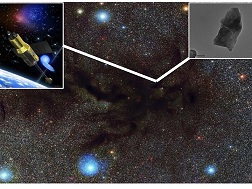SRON researcher Elisa Costantini will receive a Vidi grant from Dutch science financier NWO. Costantini and her team will study the primaeval dust in the interstellar medium to shed new light on for instance star formation and the formation of planets. With the grant, which will add up to a maximum of 800.000 euros, Costantini will be able to set up her own new research line.

Dust is a small but fundamental component of the interstellar medium, between the stars in star systems. Dust takes part in every process in the universe, from star formation in distant galaxies down to the final evolution of protoplanetary disks into planets. Therefore understanding the dust properties literally implies getting to know the universe around us.
Powerful
X-rays are a powerful means to investigate dust properties. However this potential has not yet been exploited in a systematic way, using modern tools. Costantini and her team will add a missing piece to the primaeval dust puzzle, by means of a thorough analysis of the dust spectral properties in X-rays. To do that the team will systematically study the diffuse interstellar dust both in our galaxy and in nearby galaxies using high resolution X-ray spectroscopy of a large sample of sources, such as X-ray binaries. A lot of information about the characteristics of the primeval dust can be derived from the absorption and scattering of the light from the X-ray source, due to dust along the line of sight.
Costantini: “I have been waiting for a long time for a chance to solve the primeval dust puzzle. This in turn may be the key to solving other big astrophysical questions which can be best studied in X-rays. So I really can’t wait to get started. We’ll be covering exciting new territory.”
For their research Costantini and her team will exploit the large data base provided by the X-ray satellites Chandra and XMM-Newton, currently in operation. The research will also benefit from the new data of the Japanese satellite Astro-H, which will be launched late 2015.”
Models
This large project will be fundamental to shed new light on the dust nature in different environments, which can be best investigated in the X-ray band. This will in turn influence dust theoretical models, widely needed in any field of astronomy.


